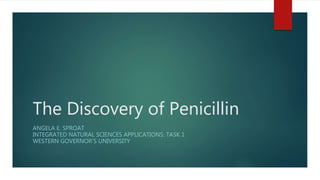
Presentation1 Penicillin
- 1. The Discovery of Penicillin ANGELA E. SPROAT INTEGRATED NATURAL SCIENCES APPLICATIONS: TASK 1 WESTERN GOVERNOR’S UNIVERSITY
- 2. The Discovery of Penicillin: How Our Understanding of Antibiotics Have Changed Sir Alexander Fleming was credited for the discovery of Penicillin in 1928.
- 3. Example 1Penicillin: Before Antibiotics Before 1928, fatal infections were part of everyone’s life. Infections routinely killed millions of people throughout the world. A simple cut could become a fatal injury due to bacterial infections that could not be treated. In 1918-1919, the Spanish Flu epidemic, actually a combination of viral and bacterial disease killed millions around the world. More died from Spanish Flu than were killed in World War 1. In early history, plants, moldy bread and warm soil were often used to treat wounds. Patients were given beer soup, snake skins, frog bile and sour milk as a protection against infections Sweetmeat was used as a desiccant and antibacterial
- 4. Example 2 : Before Antibiotics Ninety percent of children that contacted bacterial meningitis died Strep throat was considered a fatal disease and was responsible for the death of George Washington Patients that had whooping cough, pneumonia or tuberculosis increased their chances of dying from bacterial infection
- 5. Example 3: The Discovery of Penicillin Sir Alexander Fleming was considered a careless worker while in the lab At the time of the discovery, Fleming was experimenting on the influenza virus. While Fleming was on vacation, a mold developed on a contaminated culture plate. After examining the plate, Fleming noticed the mold prevented the growth of staphylococci bacteria. The mold was described as “ a fluffy white mass which rapidly increased in size and after a few days sporulates”, and changed from green to yellow.
- 6. Example 4: The Early Years In the experimental stages, penicillin had no effect on gram negative bacteria, but had an effect on gram positive bacteria such as streptococcus. In 1942, the first patient was treated successfully for streptococcal septicemia. Penicillin demands were high, but supplies were limited. During the first early months of 1943, there were only 400 million units of penicillin available.
- 7. Part 3 Historical Event: Penicillin helped the Allies win World War 2 by saving lives of wounded soldiers This antibiotic was effective against gangrene, a common cause of death on the battlefield Penicillin treatment prevented septicemia (blood poisoning) from wounds received It also caused a decrease in emergency amputations after injury
- 8. Social and Historical Context Calvin Coolidge was president of the United States (1923-1929) when penicillin was discovered Penicillin was not supported by the public during its early years. It took several years before it was considered “safe”. Mass production began in 1944 after scientists accepted its usefulness.
- 9. Impact of Historical Event Between 1944 and early 1970s, life expectancy jumped by eight years. In 1969, US Surgeon General William Stewart was quoted, “ close the books on infectious diseases.” He was appointed tenth Surgeon General of the United States from 1965 to 1969
- 10. Supporting Example 1 Due to the discovery of penicillin, this antibiotic has been regarded as one of the greatest achievements in medicine. Penicillin has reduced the number deaths from infections caused by accidental injury or exposure to pathogenic bacteria It also reduced the number of post-surgical infections and helped lead to the development of organ transplants and even open heart surgery
- 11. Supporting Example 2 Penicillin has led to the discovery of other antibiotics Tetracyclines Sulfa Drugs Erythromycin Cephalosporins Penicillin mold with dead zone around the edge of plate.
- 12. Supporting Example 3 Antibiotic Resistance By the 1950s, the emergence of resistance came on the scene. At the end of the 1960s, no more antibiotics were not being developed. Most work was done on reducing toxicity and antibiotic resistance. Antibiotic resistance occurs when antibiotics lose their ability to control or kill bacterial. Antibiotic resistance can occur with or without human control. Bacteria can produce and use antibiotics against other bacteria. Patients can overuse/abuse antibiotics
- 13. The Discovery of Penicillin "One sometimes finds what one is not looking for" (Sir Alexander Fleming)
- 14. Works Cited